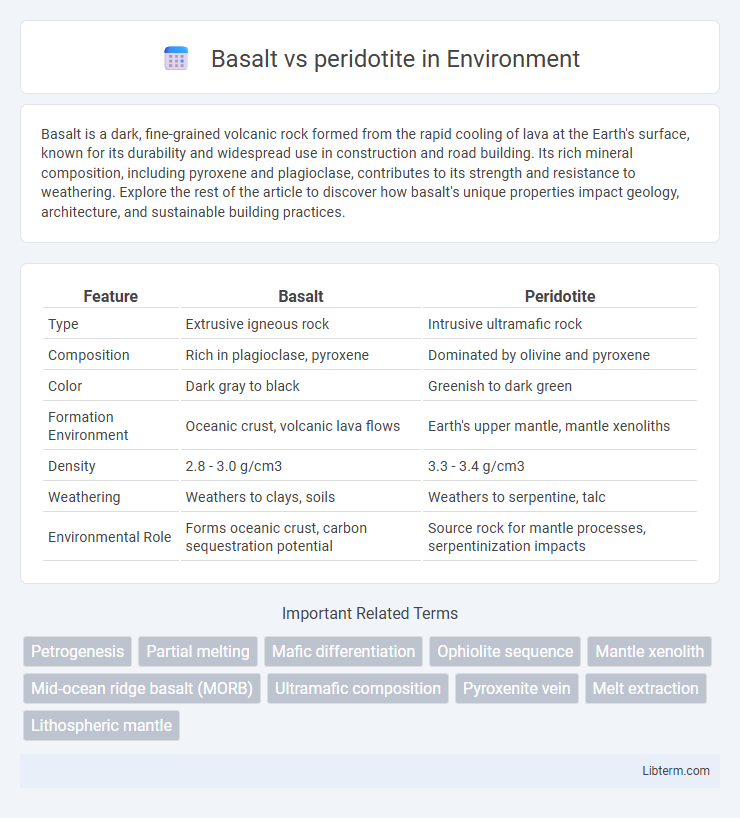Basalt is a dark, fine-grained volcanic rock formed from the rapid cooling of lava at the Earth's surface, known for its durability and widespread use in construction and road building. Its rich mineral composition, including pyroxene and plagioclase, contributes to its strength and resistance to weathering. Explore the rest of the article to discover how basalt's unique properties impact geology, architecture, and sustainable building practices.
Table of Comparison
| Feature | Basalt | Peridotite |
|---|---|---|
| Type | Extrusive igneous rock | Intrusive ultramafic rock |
| Composition | Rich in plagioclase, pyroxene | Dominated by olivine and pyroxene |
| Color | Dark gray to black | Greenish to dark green |
| Formation Environment | Oceanic crust, volcanic lava flows | Earth's upper mantle, mantle xenoliths |
| Density | 2.8 - 3.0 g/cm3 | 3.3 - 3.4 g/cm3 |
| Weathering | Weathers to clays, soils | Weathers to serpentine, talc |
| Environmental Role | Forms oceanic crust, carbon sequestration potential | Source rock for mantle processes, serpentinization impacts |
Introduction to Basalt and Peridotite
Basalt is a fine-grained extrusive igneous rock formed from the rapid cooling of low-viscosity lava rich in iron and magnesium, primarily composed of plagioclase and pyroxene minerals. Peridotite is a coarse-grained intrusive igneous rock predominantly composed of olivine and pyroxenes, representing the main constituent of Earth's upper mantle. Both rocks differ in origin, texture, and mineral composition, with basalt originating from volcanic surface eruptions and peridotite occurring deep within the mantle.
Geological Formation Processes
Basalt forms from the rapid cooling of low-viscosity magma at or near Earth's surface, primarily at mid-ocean ridges and volcanic hotspot regions, resulting in fine-grained volcanic rock. Peridotite originates from the slow crystallization of ultramafic magma deep within the mantle, characterized by coarse-grained texture and high olivine content, often exposed through tectonic uplift or mantle xenoliths. These contrasting geological formation processes reflect their distinct tectonic settings and mineral compositions, with basalt representing extrusive igneous activity and peridotite embodying primordial mantle material.
Chemical Composition Comparison
Basalt primarily consists of about 45-55% silica (SiO2), with higher concentrations of iron (Fe), magnesium (Mg), and calcium (Ca) compared to other igneous rocks, featuring plagioclase feldspar as the dominant mineral. Peridotite contains lower silica content, typically less than 45%, and is rich in olivine (up to 90%) and pyroxenes, resulting in elevated levels of magnesium and iron. The stark contrast in silica content and mineralogy between basalt and peridotite reflects their formation from different parts of the Earth's mantle and crust.
Mineralogical Differences
Basalt primarily consists of plagioclase feldspar and pyroxene minerals, with minor amounts of olivine and magnetite, whereas peridotite is dominated by olivine and pyroxenes, especially orthopyroxene, with very little plagioclase. The mineral composition of basalt is representative of mafic volcanic rock formed from rapid cooling at the Earth's surface, while peridotite is an ultramafic intrusive rock found in the Earth's mantle. These mineralogical differences reflect their distinct formation environments and geochemical characteristics, with peridotite exhibiting a higher magnesium and iron content compared to the more silica-rich basalt.
Textural Characteristics
Basalt exhibits a fine-grained, aphanitic texture due to rapid cooling of lava at the Earth's surface, with phenocrysts often embedded in a fine matrix. Peridotite, on the other hand, displays a coarse-grained, phaneritic texture, characterized by large, interlocking crystals of olivine and pyroxene formed deep within the mantle. The distinct textural differences reflect their contrasting cooling histories and geological environments.
Occurrences and Global Distribution
Basalt predominantly occurs at mid-ocean ridges, oceanic islands, and continental flood basalt provinces, making up over 70% of the Earth's volcanic crust. Peridotite is mainly found in the Earth's upper mantle and as xenoliths in basaltic lavas, with significant exposures in ophiolite complexes and intrusions such as the Ivrea Zone in Italy and the Oman Ophiolite. Globally, basalt dominates oceanic crust and volcanic arcs, while peridotite's presence is primarily restricted to mantle-derived ultramafic terrains and mantle xenolith localities.
Role in Plate Tectonics
Basalt forms at mid-ocean ridges during seafloor spreading, creating new oceanic crust and driving plate divergence. Peridotite, primarily found in the Earth's mantle, undergoes partial melting to generate basaltic magma, fueling mantle convection and subduction processes. The interplay of basalt creation at spreading centers and peridotite recycling in subduction zones is fundamental to the plate tectonic cycle.
Industrial and Economic Uses
Basalt, a fine-grained volcanic rock, is widely used in construction for aggregates, road base materials, and as crushed stone due to its durability and abundance. Peridotite, an ultramafic igneous rock, is valuable for its high magnesium and iron content, making it a key source for extracting minerals like olivine and chromite, essential in refractory materials and metal production. Both rocks contribute to industrial applications, but basalt dominates in infrastructure projects while peridotite is crucial in metallurgical processes.
Weathering and Surface Interactions
Basalt weathers rapidly due to its fine-grained texture and higher density of volcanic glass, promoting the formation of clay minerals and iron oxides on the surface. Peridotite, rich in olivine and pyroxene, undergoes carbonation and serpentinization processes, leading to the release of magnesium and calcium ions that influence soil pH and local geochemistry. Surface interactions of basalt favor faster nutrient cycling in ecosystems, whereas peridotite contributes to long-term carbon sequestration through mineral carbonation reactions.
Summary: Key Differences and Applications
Basalt, a fine-grained extrusive igneous rock, primarily consists of plagioclase and pyroxene minerals, while peridotite is a coarse-grained intrusive rock dominated by olivine and pyroxene, making it ultramafic. Basalt is commonly used in construction, road base materials, and as a source of industrial aggregates, whereas peridotite serves crucial roles in geochemical carbon sequestration and is a primary rock of the Earth's mantle. Key differences include texture, mineral composition, origin, and typical applications in civil engineering and environmental technologies.
Basalt Infographic

 libterm.com
libterm.com